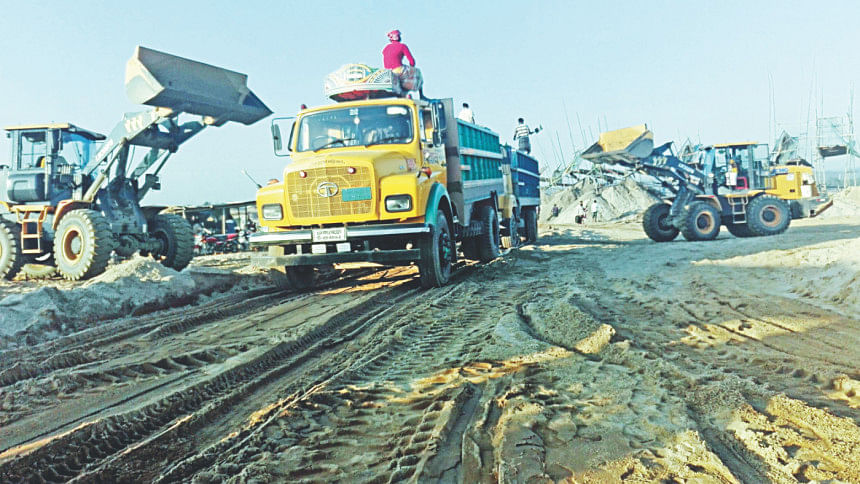Someshwari is being butchered

Violating a court directive, some unscrupulous people continue to illegally lift sand from the Someshwari river, posing a threat to ecological diversity.
However, the local administration turns a blind eye paving the way for the destruction of the Someshwari, considered an abundant source of high-quality sand.
Locals and environmentalists say the once crystal-clear river is nearing its death due to unlawful and unregulated extraction of sand and stone by using illegal "shallow" machines.
The Netrokona district administration has leased out seven spots of the river for lifting sand.
The leased out balumahals (designated sand quarries) are Bijoypur-Bhawanipur (287 acres); Teribazar-Shibganj Bazar (976 acres); Teribazar-Chaitati (287 acres); Birisiri-Keronkhola (341 acres); Gaoakandia (142 acres); Jhanjail-Shankarpur (140 acres); Omargaon-Hashanoagaon-Bishauti (35 acres).
The administration imposes certain conditions for sand lifting -- including that sand can be only lifted from morning to dusk and motorised pumps or dredgers cannot be used in the process.
However, leaseholders continue to lift sand round the clock; at times, up to 200 dredgers can be seen in the river lifting sand, alleged locals.
During the rainy season, dredgers are brought close to the riverbank for sand lifting, threatening the adjacent areas with erosion, said a businessman of Teribazar area of Durgapur town.
With the aim of ending this illegal practice, Bangladesh Environmental Lawyers Association (Bela) filed a writ petition with a High Court bench in 2015.
In response, the HC on July 2015 issued a rule upon the government asking why the leasing out of balumahals in the river shall not be declared illegal.
The court also ruled why the government shall not be directed to declare Someshwari an ecologically critical area.
In addition, it directed the local administration to regulate and monitor sand lifting in the leased-out areas so that no damage occurs to the river and its ecology.
The HC also directed the local administration to assess the impact of sand lifting on the river.
The court directives are yet to be implemented. The unregulated lifting of sand through shallow machines are posing a serious threat to the river, said locals and Bela officials.
"Hundreds of trucks move in the area, while many shallow machines are being continuously operated. These are clear evidence that the High Court order was not implemented," Bela Chief Executive Syeda Rizwana Hasan told The Daily Star last month.
Spillage of burnt lubricant and oil from shallow machines puts the river's traditional fishes like mohashol, kengra, bata, maitta, popa and baila, at risk, said locals.
On December 30 last year, Bela organised a coordination meeting with locals at Birisiri auditorium in Durgapur to chalk out a plan to protect the river and the environment.
In the meeting, locals expressed their anger and said they had been organising different protest programmes -- including forming human chains and submission of memorandums to the local administration -- for the past couple of years to stop indiscriminate sand lifting from the river.
But no action has so far been taken, they said.
As a direct result, environmental pollution in Durgapur municipal area has reached a severe stage.
Hundreds of sand trucks ply this area at all times, which both damages the road and cause large clouds of dust in the air.
This correspondent while visiting the area last month was told by locals that more than 600 trucks ply Mymensingh-Durgapur road daily, each truck carrying more than 30 tonnes of sand.
Mamun Mia, a young truck driver from the adjacent Purbadhala upazila, said the sand business is lucrative in Durgapur.
"For every truck, we have to pay Tk 9,500 for both sand and tolls. It is sold at Tk 20,000 in Dhaka and the rate increases with the distance."
Didarul Alam Tarafder, executive engineer of the Roads and Highways Department in Netrokona, said overloaded trucks were causing serious problems to the Mymensingh-Durgapur road.
"The road has maximum capacity for vehicles loaded with 16 tonnes but truckers are carrying 30 to 40 tonnes of sand," he said.
"We have repeatedly informed the matter to the district administration and police. But no action has yet been taken against overloading," lamented the engineer.
A leaseholder, Anjon Sarker Liton, said, "We are collecting sand following the government instructions."
He denied violating rules.
Assistant Commissioner (AC-Land) of Durgapur Ruel Sangma said the local administration has already stopped illegal sand and stone extraction from local canals and other water bodies.
He also warned of taking action against rule violators.
Contacted over phone, Netrokona's Deputy Commissioner Moinul Islam said he was not aware whether extracting sand after dusk was prohibited.
Asked about the High Court directives to assess the impact of sand lifting on the river, the DC said he did not know updated information on this.
Mohammad Akhtaruzzaman, executive engineer of the Water Development Board (WDB) in Netrokona, said sand lifting would not change the course of the river.
The WDB official also claimed that more sand lifting will generate higher revenues for the government.
An official of the Department of Environment in Netrakona, preferring not to be named, termed sand lifting "absolute nonsense" and harmful to the river ecology, running a serious risk of erosion.

 For all latest news, follow The Daily Star's Google News channel.
For all latest news, follow The Daily Star's Google News channel. 



Comments